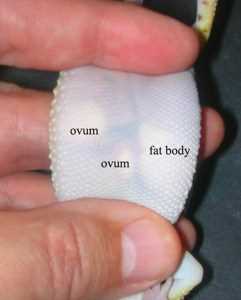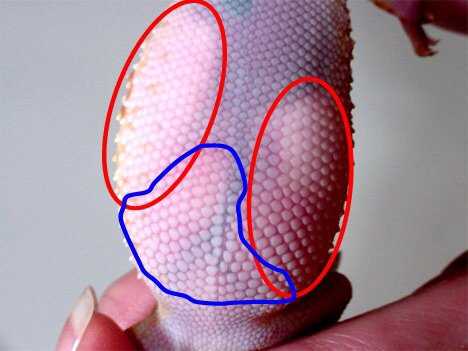Ovulation in leopard geckos is influenced by various factors, with temperature being a key element. These cold-blooded creatures rely on external temperature cues to regulate their reproductive cycles. When the temperature is at the optimum range, usually around 88-90°F (31-32°C), it triggers the production of certain hormones that initiate ovulation.
Once a female leopard gecko has mated, the sperm is stored in special tubules within her reproductive tract. The reproductive organs of these geckos are uniquely designed to store sperm for an extended period of time without it losing its ability to fertilize eggs. This allows them to fertilize their eggs even months after mating.
During ovulation, the female leopard gecko will typically develop follicles, which are small, fluid-filled sacs that contain the mature eggs. These follicles will grow until they reach an optimal size, at which point they will rupture, releasing the eggs into the oviducts. The eggs then travel through the oviducts and eventually get laid by the female.
Ovulation Process in Leopard Geckos
Egg Production
Ovulation Process
Once the eggs have matured, the leopard gecko’s body prepares for ovulation. During ovulation, the fully developed eggs are released from the ovaries into the reproductive tract. This process is triggered by hormonal changes and signals from the gecko’s body.
The release of the eggs occurs through the opening of the oviducts, which are the tubes connecting the ovaries to the uterus. The mature eggs pass through the oviducts and into the uterus, where they await fertilization. If a compatible male gecko is present, mating may occur, and fertilization can take place in the uterus.
Fertility and Reproductive Cycle
Ovulation is a critical event in the reproductive cycle of leopard geckos as it determines the fertility of the female gecko. A successful ovulation process indicates that the gecko’s reproductive system is functioning correctly, and she is capable of producing viable eggs for fertilization.
The reproductive cycle of leopard geckos can vary depending on various factors such as temperature, lighting, and overall health. Typically, a female gecko will undergo ovulation and produce eggs every 3-4 weeks during the active breeding season.
The ovulation cycle of leopard geckos is influenced by various factors, such as temperature, lighting, and overall health. These factors play a significant role in regulating the reproductive hormones and determining the timing of ovulation.
Ovulation Process
During the ovulation process, the leopard gecko’s ovaries produce mature eggs that are released into the oviduct. The eggs then travel through the oviduct, where they can be fertilized if the female has mated with a male. If the eggs are not fertilized, they will be absorbed by the body.
Temperature also affects the ovulation cycle of leopard geckos. A cooler environment induces ovulation, while warmer temperatures inhibit it. This is because leopard geckos are ectothermic animals, meaning their body temperature is regulated by the environment. Breeders can manipulate the temperature to control ovulation and optimize breeding conditions.
Ovulation Cycle and Fertility
The ovulation cycle of leopard geckos usually lasts around 3 to 6 weeks. During this time, the female gecko becomes receptive to mating and seeks out a male. If successful breeding occurs, the fertilized eggs will develop and be laid within a few weeks after mating.
Monitoring the ovulation cycle is essential for assessing the fertility of a female leopard gecko. A regular and consistent ovulation cycle indicates that the female is healthy and capable of producing viable eggs. Irregularities or difficulties in ovulation can be a sign of reproductive issues or underlying health problems that may require veterinary attention.
| Factors Affecting Ovulation | Effects on Ovulation |
|---|---|
| Temperature | Regulates ovulation cycle |
| Lighting | Influences reproductive hormones |
| Overall Health | Affects fertility and ovulation regularity |
Signs and Symptoms of Ovulation in Leopard Geckos
1. Increase in body temperature:
2. Changes in behavior:
During ovulation, leopard geckos may display changes in their behavior. They may become more active and restless, showing increased interest in their surroundings. Some geckos might also exhibit a change in appetite, either eating less or becoming more voracious.
3. Enlargement of the abdomen:
It is essential to note that not all leopard geckos may exhibit these signs and symptoms of ovulation. Some individuals may show subtle or no visible signs at all. Therefore, it is crucial to observe individual geckos closely and maintain a detailed record of their reproductive behaviors to improve breeding success.
Factors Affecting Ovulation in Leopard Geckos
1. Mate Availability
One of the most important factors influencing ovulation in leopard geckos is the availability of a suitable mate. Female leopard geckos have a higher chance of ovulating when they are exposed to a male gecko. The presence of a potential mate triggers hormonal changes that stimulate the release of eggs from the ovary.
2. Temperature
Temperature also plays a vital role in the ovulation cycle of leopard geckos. These reptiles are ectothermic, meaning their body temperature depends on the environment. The optimal temperature for ovulation in leopard geckos is around 88-90 degrees Fahrenheit (31-32 degrees Celsius). Maintaining the correct temperature is crucial for successful ovulation and egg development.
3. Reproductive Cycle
4. Health and Nutrition

The overall health and nutritional status of a leopard gecko can affect its ability to ovulate. An unhealthy or malnourished gecko may have disrupted hormonal levels, leading to irregular ovulation or even infertility. Providing a balanced diet and ensuring proper husbandry practices are essential for maintaining optimal reproductive health in leopard geckos.
5. Genetics
Genetics also play a role in ovulation in leopard geckos. Some geckos may have genetic predispositions that affect their ability to ovulate regularly or produce healthy eggs. Breeders often consider the genetic background of geckos when selecting mating pairs to ensure successful breeding and healthy offspring.
The Importance of Ovulation in Breeding Leopard Geckos
The Ovulation Cycle
During the pre-ovulatory phase, the female leopard geckos may also display specific behaviors, such as rubbing against surfaces and exhibiting a receptive posture. These behaviors indicate that they are ready to mate and potentially reproduce.
The Role of Temperature
Temperature plays a significant role in the ovulation process of leopard geckos. These reptiles are ectothermic, meaning their body temperature is regulated by external sources. A stable and controlled temperature is essential for inducing ovulation in female geckos.
By providing a suitable temperature gradient, breeders can simulate the natural conditions required for successful ovulation. This can be achieved through the use of heat lamps or heating pads in the gecko’s enclosure. Maintaining a temperature range of 88-92°F (31-33°C) on the warm side of the enclosure is recommended for promoting ovulation.
Ensuring Fertility
Once a female leopard gecko has ovulated, it is crucial to ensure that she mates with a male gecko to fertilize the eggs. Introducing a male gecko into the female’s enclosure during the pre-ovulatory phase is the recommended approach.
Male geckos will exhibit specific mating behaviors, such as tail-waving and head-bobbing, to signal their interest in mating. The female leopard gecko should display a receptive posture to indicate her willingness to mate. Proper monitoring and observation during this crucial time will increase the chances of successful reproduction.
Egg Production and Incubation

After ovulation and successful mating, the female leopard gecko will begin developing and laying eggs. The number of eggs produced can vary, but it is essential to provide a suitable nesting area with appropriate substrate for the female gecko to lay her eggs.
Once the eggs are laid, they should be carefully collected and transferred into an incubator set at the appropriate temperature and humidity levels. This ensures the optimal conditions for the eggs to develop and hatch into healthy gecko offspring.
Problems and Complications Related to Ovulation
Ovulation is a crucial part of the reproductive cycle in leopard geckos. It is the process by which a female gecko releases eggs for potential fertilization. However, problems and complications can arise during this process, which can negatively impact the gecko’s health and breeding potential.
Ovulation Failure
One of the common problems that can occur is ovulation failure. This happens when a female gecko fails to release eggs during her ovulation cycle. There can be various reasons for this, such as stress, inadequate nutrition, or hormonal imbalances. Ovulation failure can disrupt the gecko’s reproductive cycle and prevent successful breeding.
Egg Binding
Egg Retention
Egg retention is another issue that can occur during ovulation. It happens when a female gecko retains her eggs instead of laying them. This can lead to various health problems, including infection and organ damage. Egg retention can be caused by factors such as stress, malnutrition, or genetic predisposition. It is crucial to monitor the ovulation cycle and provide appropriate care to avoid egg retention.
Egg Infertility
Impacted Eggs
Impacted eggs are eggs that are stuck inside the female gecko’s body. This can be caused by factors such as inadequate calcium levels, dehydration, or improper nesting materials. Impacted eggs can lead to serious health issues and even death if not treated promptly. It is crucial to provide proper nutrition, hydration, and nesting materials to prevent impacted eggs.

I’m Lena Adams—a product of an unconventional upbringing in the African wilderness. My father, a daring explorer of African wildlife, sparked my fascination with reptiles, a passion that intertwined with the tragic loss of my mother during an expedition, leaving an indelible mark on my life. Driven to understand the creatures that captivated my parents, I embarked on my journey, sharing insights about reptiles, frogs, and lizards on my website. Through my explorations and conservation efforts, I honour my family’s legacy while seeking connections—to the creatures, nature, and the mother whose presence I yearn to understand.
